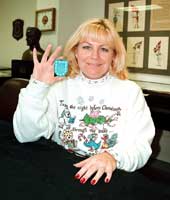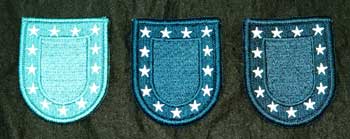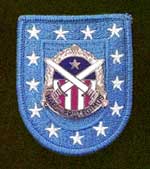
 |
|
Shinseki approves beret flash
Since Gen. Erik K. Shinseki announced Oct. 17 that the Army will begin wearing the black beret on the next Army birthday, there has been some discussion as to whether soldiers will wear a universal flash or distinctive unit flashes. That discussion ended Thursday when Shinseki unveiled the new universal flash. The new flash has a light blue background, what the Institute of Heraldry calls "bluebird," with 13 white stars superimposed inside its outer border. "The flash is designed to closely replicate the colors [flag] of the commander in chief of the Continental Army at the time of its victory at Yorktown," said Pam Reece, an industrial specialist in textiles with the Army's Institute of Heraldry. Those colors are now carried by Company A of the 3rd U.S. Infantry (The Old Guard), known as "The Commander in Chief's Guard." "It's the CSA's choice and takes the Army back to its very beginning," said Reece, who has been with the Institute of Heraldry for 13 years. "The 13 stars are significant of the original 13 colonies," Reece said. "I think it's really neat that they went back and took the colors of the Continental Army. If you want to go back and put some pride [back into the Army] you can't back any further than that." "It is time for the entire Army to accept the challenge of excellence that has so long been a hallmark of our special operations and airborne units," Shinseki said. Adopting the berets will be "another step toward achieving the capabilities of the objective force" of Army transformation, he said. Initially, Reece and other institute staff members created four beret flash designs from which Shinseki made his selection. The other recommendations included a flash with a black background and yellow border, colors which are assumed to represent the Army's colors; one with a green background and yellow border, also colors associated with the Army and the third design was much the same as the one selected, however with a darker - old-glory blue -- background. The design process for the flash was more rapid than normal, said Reece, who is responsible for working with all Army cloth items, such as insignia, flags and ribbons. "The first meeting was with the Sergeant Major of the Army [Sgt. Maj. of the Army Jack L. Tilley] Oct. 26," Reece said. "We completed development on Nov. 23, in less than 30 days. "The thing that was most amazing was a one-day turn-around on the creation of prototypes, which were presented to the SMA Oct. 27," she said. On Nov. 3, Army officials were confident on their design choice, however they still needed to come to a decision on the final color, Reece said.
"This was amazing," she said. "Development of a flash normally takes three months, Rainbow did this development in three days." Great credit for increasing the speed of this process goes to Richard Rapoza, our artist who turned the design into something manufacturable, Reece added. "I'm proud to have had a hand in it, working with the design and turning [Shinseki's] ideas into a product," said Rapoza, who has been an illustrator with the Institute of Heraldry for eight years. During the next large-group meeting, Nov. 17, the flashes were shown to all the parties involved in this project. "At that time, everybody was about 98-percent sure of the final flash," Reece said. "The Old Guard's replica colors were brought in to ensure that we in fact had the right color. And on Nov. 20 I got the answer -- it would be bluebird." Each new flash is a semi-circular shield measuring 1 7/8 inches wide by 2 1/4 inch high, and will consist of 4,001 stitches and two colors. All soldiers will initially wear the universal flash, except for those in units that already have berets, such as Ranger, Airborne and Special Forces. These troops will continue to wear the beret flashes they currently have.
Black berets, which will initially be issued to soldiers, will be shipped with the universal flash already sewn on it, Reece said. Additionally, the universal flash will eventually be replaced by unit-specific flashes. The universal flash is to be worn for a period of one year, Reece said. During that year, the Institute of Heraldry will be working with representatives of the Army's 16 major commands to design and develop distinctive flashes. "Just how far below MACOM level distinctive unit flashes will be created has not yet been decided," said Reece. For now, the Institute of Heraldry's part in flash development is finished. "We've given 160 of the new flashes to the sergeant major of the Army, and the cartoon [a manufaturing-specifications diagram] has gone out to manufacturers from the Defense Supply Center, Philadelphia, which is responsible for procurement of the berets," Reece said. "Initially some four to five million berets are to be procured." (Hall is editor of the Fort Belvoir Eagle. Joe Burlas of the Army News Service contributed to this report.) |


